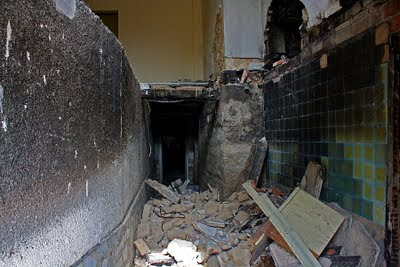Despite we were heading for the bunkers in Madrid, we had to cross the Sierra de Guadarrama. This mountain range is part of the Sistema Central, which crosses Spain and Portugal. Our first stop was the Segovian village of Valsaín, where we found more than one surprise. The first one was this huge ruined building.
Later we found out it was the palace of Philip II.Before that it was a hunting residence belonging to the Trastámara family, but Philip II enlarged it during the C. 16th. At some point it was bigger than the Palace of la Granja de San Ildefonso, not very far from there. It was used until Charles II´s reign, but a fire destroyed it in 1682. Most of what remained was salvaged to build the Palace of La Granja, and what was left was abandoned. Its condition worsened in 1869, when it became a private property. It was not a big change when it was declared National Monument in 1931, because up until then nothing had been done to preserve it. There is currently a project to restore it as a luxury hotel, but so far there are no signs of any real intention to recover the place.
This is the palace in another time...
And this is what we can find today.
We leave the palace and we started looking for the Valsaín trenches and pillboxes. The area saw the Battle of la Granja in 1936, when Republican forces crossed Navacerrada coming from Madrid and attacked National positions in the province of Segovia. Some of this trenches have been restored, and there is a trail following them. Near there we could find a visitor centre in which you can find all the information related to the trail. Then we explored some of its most important locations.
Some defence points, and the trenches linking them.
The trenches have been dug again, because the original ones have been naturally refilled after more than seventy years. In spite of that, these old trenches can still be seen because stones mark their location.
Another interesting location was the command post from which defence was organized.
Walking up the slope there was this outpost where the advance of enemy troops through the mountains could be controlled.
Leaving the trail we decided to climb the Cerro del Puerco (The Hog´s Hill), where we found plenty of remains even we could not explore all the zone. The (non-existent) path was far from easy...
Coming back to the trail we found the biggest position of the area. The main bunker had a twisted entrance in order to reduce the effects of the shockwaves during an attack.
Here ends our visit to Valsaín, and then we head to the Alto del León (The Lion´s Top), the frontier with Madrid. There we found another abandoned building, unrelated to the Civil War though.
Casa Hilario, an abandoned and very thrashed road restaurant. Opposite there is a warehouse which still contains some remains of the restaurant.
But the really interesting feature are the bunkers. Almost next to the road we found this one:
There also are several crosses remembering the fallen.
There is also the position of el Cerro de la Sevillana, at one of the peaks near the mountain pass of the Alto del León. In our way there we found radio tower.
It is also interesting (and impressive) this massive ventilation shaft, from the Guadarrama tunnel.
Our trip through the remains of the Civil War in Madrid will continue in another post, visiting some of the most important locations of the period.
To read the second part of our trip in Madrid, click here. (Spanish version)
To read our post of the Somosierra front, click here. (Spanish version)










































































